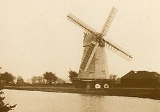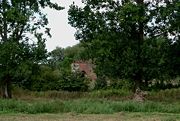
South Ockendon Windmill
Encyclopedia
South Ockendon Windmill was a Smock mill
at South Ockendon
, Essex
, England
which collapsed on 2 November 1977.
s in the base in addition to those driven by wind. The mill may have been built with the waterwheel from new. The first reference to the waterwheel was in 1845. In June 1853 the mill was struck by lightning
. A steam engine had been installed by 1912 and the mill ceased working in 1923. The mill collapsed on 2 November 1977. The wreckage was taken into store at South Woodham Ferrers
by Vincent Pargeter, millwright to Essex County Council. A plan to restore and exhibit some of the remains in South Ockendon was shelved in 1994. The remains are still in store, available to be used if a replica of the mill is ever built, either on its original site or elsewhere. In 2005, it was announced that some of the machinery was to be used in the restoration of Halvergate
Windmill, Norfolk
.
 South Ockendon Windmill was a three storey smock mill on a two storey brick base, with a stage at first floor level. The mill had two double Patent sails
South Ockendon Windmill was a three storey smock mill on a two storey brick base, with a stage at first floor level. The mill had two double Patent sails
and two single Patent sails. The boat shaped cap was winded by a fantail
.
The smock was 30 in 6 in (9.3 m) from sill to curb. The mill was 16 in 2 in (4.93 m) diameter at the curb externally, the cant posts being about 11 inches (279 mm) by 11½ inches (292mm). The stage was at first floor level, 8 in 4 in (2.54 m) above the ground.
The cap was boat shaped, similar to those found on Norfolk
windmills. Winding was by an eight-bladed fantail.
windshaft carrying two double Patent sails and two single Patent sails with a span of 64 feet (19.51 m). The double shuttered sails had eleven bays of three shutters and the single shuttered sails had nine bays of three shutters.
Smock mill
The smock mill is a type of windmill that consists of a sloping, horizontally weatherboarded tower, usually with six or eight sides. It is topped with a roof or cap that rotates to bring the sails into the wind...
at South Ockendon
South Ockendon
South Ockendon is settlement and Church of England parish in the Thurrock borough and unitary district in Essex in the East of England, United Kingdom.-History:...
, Essex
Essex
Essex is a ceremonial and non-metropolitan county in the East region of England, and one of the home counties. It is located to the northeast of Greater London. It borders with Cambridgeshire and Suffolk to the north, Hertfordshire to the west, Kent to the South and London to the south west...
, England
England
England is a country that is part of the United Kingdom. It shares land borders with Scotland to the north and Wales to the west; the Irish Sea is to the north west, the Celtic Sea to the south west, with the North Sea to the east and the English Channel to the south separating it from continental...
which collapsed on 2 November 1977.
History
South Ockendon Windmill was built in the 1820s. A date of 1829 is often quoted but the mill was marked on the Greenwoods' map of 1825. The mill was a combined mill, with a waterwheel driving a pair of millstoneMillstone
Millstones or mill stones are used in windmills and watermills, including tide mills, for grinding wheat or other grains.The type of stone most suitable for making millstones is a siliceous rock called burrstone , an open-textured, porous but tough, fine-grained sandstone, or a silicified,...
s in the base in addition to those driven by wind. The mill may have been built with the waterwheel from new. The first reference to the waterwheel was in 1845. In June 1853 the mill was struck by lightning
Lightning
Lightning is an atmospheric electrostatic discharge accompanied by thunder, which typically occurs during thunderstorms, and sometimes during volcanic eruptions or dust storms...
. A steam engine had been installed by 1912 and the mill ceased working in 1923. The mill collapsed on 2 November 1977. The wreckage was taken into store at South Woodham Ferrers
South Woodham Ferrers
South Woodham Ferrers is a town and civil parish in the borough of Chelmsford, Essex, England. It is approximately from London and, according to the 2001 census, has a population of 16,629. The town is located east of Fenn Creek, and near where it meets the River Crouch...
by Vincent Pargeter, millwright to Essex County Council. A plan to restore and exhibit some of the remains in South Ockendon was shelved in 1994. The remains are still in store, available to be used if a replica of the mill is ever built, either on its original site or elsewhere. In 2005, it was announced that some of the machinery was to be used in the restoration of Halvergate
Halvergate
Halvergate is a civil parish in the English county of Norfolk, north of Reedham., halfway between the Rivers Bure and Yare, within The Broads National Park.It covers an area of and had a population of 468 in 202 households as of the 2001 census....
Windmill, Norfolk
Norfolk
Norfolk is a low-lying county in the East of England. It has borders with Lincolnshire to the west, Cambridgeshire to the west and southwest and Suffolk to the south. Its northern and eastern boundaries are the North Sea coast and to the north-west the county is bordered by The Wash. The county...
.
Description

Windmill sail
Windmills are powered by their sails. Sails are found in different designs, from primitive common sails to the advanced patent sails.-Jib sails:...
and two single Patent sails. The boat shaped cap was winded by a fantail
Windmill fantail
A Fantail is a small windmill mounted at right angles to the sails, at the rear of the windmill, and which turns the cap automatically to bring it into the wind. The fantail was patented in 1745 by Edmund Lee, a blacksmith working at Brockmill Forge near Wigan, England, and perfected on mills...
.
Mill
South Ockendon Windmill had an octagonal two storey brick base, which consisted the ground floor of the mill and a cellar. It was 26 in 4 in (8.03 m) across the flats and 8 in 4 in (2.54 m) high. The cellar was just under 8 feet (2,438 mm) high. The mill was 58 feet (17.68 m) high overall, and 50 feet (15.24 m) from ground level to the top of the cap.The smock was 30 in 6 in (9.3 m) from sill to curb. The mill was 16 in 2 in (4.93 m) diameter at the curb externally, the cant posts being about 11 inches (279 mm) by 11½ inches (292mm). The stage was at first floor level, 8 in 4 in (2.54 m) above the ground.
The cap was boat shaped, similar to those found on Norfolk
Norfolk
Norfolk is a low-lying county in the East of England. It has borders with Lincolnshire to the west, Cambridgeshire to the west and southwest and Suffolk to the south. Its northern and eastern boundaries are the North Sea coast and to the north-west the county is bordered by The Wash. The county...
windmills. Winding was by an eight-bladed fantail.
Sails and windshaft
South Ockendon Windmill had a cast ironCast iron
Cast iron is derived from pig iron, and while it usually refers to gray iron, it also identifies a large group of ferrous alloys which solidify with a eutectic. The color of a fractured surface can be used to identify an alloy. White cast iron is named after its white surface when fractured, due...
windshaft carrying two double Patent sails and two single Patent sails with a span of 64 feet (19.51 m). The double shuttered sails had eleven bays of three shutters and the single shuttered sails had nine bays of three shutters.
Machinery
The wooden Brake Wheel was of composite construction, 9 in 2 in (2.79 m) diameter. It had a wooden rim and a cast iron centre with six arms. It had been converted from clasp arm construction. The Wallower was wooden, as was the Upright Shaft. The Upright Shaft was made up of four pieces of timber. The clasp arm Great Spur Wheel was of wood. It drove three pairs of underdrift millstones, with a fourth pair being driven by the waterwheel. The wind driven millstones were all French Burr stones, two pairs being 4 feet (1.22 m) diameter and the third pair being 4 in 10 in (1.47 m) diameter. Little is known about the waterwheel except that it was undershot and drove a single pair of millstones on the first floor of the mill, which was the same floor as the wind powered millstones.Fantail
South Ockendon Windmill was winded by an eight-bladed fantail Final drive was a wooden worm gear driving onto cogs of 9 inches (229 mm) pitch at the top of the smock.Millers
- William Eve 1820 – 1829
- Thomas Banks 1845
- Thomas Bennett Sturgeon 1848
- Stephen Challis 1877
- Smith c1877 – 1919
- C and William Sturgeon 1912 – 1914
External links
- Windmill World webpage on South Ockendon Mill

